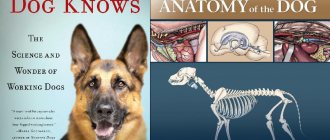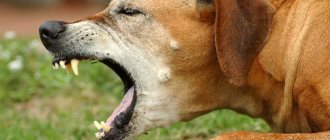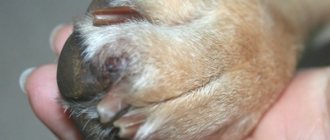Various traumatic injuries to the animal’s body are a common occurrence in the practice of dog breeders. The tail in dogs is most often susceptible to various pathological processes. Clinical signs depend on the nature of the traumatic process.
If you notice possible damage to your pet's tail, you need to take the animal to a veterinary clinic as soon as possible. At first glance, minor injuries can turn out to be serious pathologies - displacement of the vertebrae, fractures, gangrene, which are extremely difficult to treat.
Major diseases and damage to the tail in dogs
In the clinical practice of veterinarians, there is a clear distribution of pathological changes in the tail of a dog. There are mechanical damage and processes that arise as a result of complications. Mechanical damage to the tail occurs due to trauma. Various wounds, bruises, and vertebral fractures occur as a result of bites, sudden lifting of the tail, and pinching.
Tail curvatures of a congenital or acquired nature are often diagnosed. In the case of congenital deformities, the cause is anomalies of a genetic nature. Acquired ones arise due to dislocations, fractures and improperly fused tissues.
Main dog tail injuries and pathologies:
- ulcers;
- fractures;
- eczema;
- intervertebral hernia;
- gangrene.
The clinical picture in most cases is clearly expressed. So, as a result of a tail injury, with damage to the tail artery, severe hemorrhage occurs. Damage located near the base of the tail causes phlegmon, spreading to nearby tissues, rectal tissue. As a result, pararectal phlegmon, fistula or paraplegia may develop.
When the tail vertebrae are fractured, the animal practically does not move the appendage, and when palpating the site of the lesion, the animal experiences pain. The skin at the fracture site has a higher temperature than the rest of the stationary part, which remains cold due to poor circulation.
Note! If there is any abnormality in the dog’s tail, you must contact a qualified specialist. This will allow you to quickly identify the pathology and prescribe adequate treatment.
Trembling and yelping of a toy terrier
Hello, we have a toy terrier (4 years old). At night she began to squeal and tremble violently, as if a sharp pain was piercing her. At the same time, the stool is normal, there is no vomiting. The trembling did not go away by morning, the condition was sluggish, painful, the nose was dry. Temperature 37.8, breathing frequently. This has not been observed before. What could it be?
Answer 1
This is a breed of emotional dogs. They experience regular nervous and emotional overexcitation. Physically, it manifests itself as a shaking body, which is normal.
The toy terrier is constantly afraid. He is afraid of noise, screams, sudden changes in the situation, large animals, and unfamiliar people. Adaptation occurs slowly. The baby is trembling and trying to attract the owner's attention. Simulates pain. Requires regular attention, smart, cunning.
Need causes the same reaction. An animal accustomed to the tray endures it, shaking. The thin skin makes it react sharply to temperature changes. Blankets and overalls save.
A high temperature accompanied by shuddering is a sign of illness. Fever increases the temperature. The dog's nose is dry. There is lethargy and lack of interest. Veterinarian intervention is required. Treatment is prescribed.
Humans are the source of infection
An animal cannot catch a human disease. Viruses provoke inflammation at the source of infection. A weakened body suffers. Immune protection is destroyed.
The human strain of the virus is not the same as the quadruped strain. The presence of infection excludes the moment of infection during transmission. Pets become infected from other similar ones. Also sources are wild, homeless animals.
It is impossible for the owner to become a source of infection. It is possible to become a generator of causes that cause a chance of getting sick. Inattention and poor quality food do their job. The pet catches the infection.
It is important to take care of your four-legged friends. A caring owner follows the recommendations of medical workers and breeders. The owner provides comfortable living conditions and is responsible for the safety of his little friend.
Symptoms of the disease
The symptoms of various diseases are similar to each other. Trembling is a universal reaction of the body experiencing discomfort. Poisoning, virus, infection cause similar symptoms. The animal shakes, its body temperature changes.
Shaking is worth paying attention to if you don't usually see this. Symptoms may be observed: the dog is lethargic, refuses to eat, and behaves strangely. The animal falls and breathes heavily.
Poisoning will be indicated by the remains of uneaten food. Medicines, sweets, and plastic are dangerous. Medical attention required. The “glutton” is being taken to the doctors.
An elevated temperature accompanied by muscle contraction indicates illness. The patient is lethargic and lies down. May whine. Prolonged tremors require medical intervention.
Ulcer
A dog's tail is as vulnerable as other organs of a four-legged friend. One of the most common problems that occurs in dogs is ulcers. Depending on the stage of development of the pathology, there are several forms of tail ulcers:
- initial;
- developing;
- advanced ulcer.
Each form is characterized by certain symptoms and manifestations. So at the initial stage, the owner may notice hair loss and the appearance of a focus of inflammation. The developing form of the ulcer is characterized by expansion of the wound, covering new areas of the skin. In advanced stages, the ulcer affects the root part of the tail, causing necrosis and death of the tail vertebrae.
Causes
There is no single cause of tail ulcers in dogs. Doctors suggest that the main causes of this pathology are:
- mechanical damage to tissue structures;
- internal diseases of organs;
- allergic reactions in an advanced stage;
- violation of the diet.
Symptoms and diagnosis of pathology
The basic sign of an incipient tail ulcer is hair loss in the tail . With further development of the pathology, other characteristic signs appear:
- the appearance of a wound surface;
- rapid spread of focal inflammation;
- the appearance of bleeding from the wound;
- pain in the animal.
To make a correct diagnosis and further prescribe adequate treatment, a consultation with a veterinarian specializing in dermatology is necessary. An accurate diagnosis is made only after passing all the necessary tests and examination by a veterinarian.
Why does a dog tremble after vaccination?
Any vaccinations have side effects. The post-vaccination reaction is expressed by the dog's slight trembling, refusal to eat, general weakness, diarrhea or vomiting, elevated body temperature, and the appearance of painful swelling at the injection site. The occurrence and intensity of the consequences after vaccination depend on the characteristics of the animal’s body.
To avoid or minimize the side effects of vaccination, the dog needs to be prepared for the procedure - choose a qualified veterinary clinic, deworm it 1-2 weeks before the visit, and also make sure that the pet is not suffering from any disease symptoms.
Usually, all complications after vaccinations go away on their own without intervention. Alarming signs that require the services of a veterinarian include severe convulsions, allergic reactions, prolonged refusal to eat, diarrhea or vomiting for more than 3 days, body temperature exceeding 39°C, and other symptoms that do not go away or worsen.
After the vaccine, quarantine is required, during which the pet cannot be taken outside, bathed, and contact with other animals is prohibited.
It is important to monitor your pet’s condition after vaccinations and be prepared for possible complications.
Tail fractures
The owner of a four-legged friend may notice strange behavior of the pet and abnormal condition of the tail. The animal becomes nervous and quite aggressive. The dog's tail looks unnatural; one part protrudes slightly. In most cases, the injured part heals on its own. But not in all cases, healing occurs successfully; in addition, the development of consequences that affect the general well-being of the pet, namely physiological processes, cannot be ruled out. This is due to the fact that the vertebrae and bones that make up the tail are unusually rich in blood vessels and nerve fibers.
Causes
The vast majority of causes of tail fractures are due to external factors.
The main reasons are:
- pinching the tail in a door or window;
- fracture of a tail fragment due to a collision;
- fight with other dogs;
- disturbances in the functioning of body systems.
Owners of decorative breeds of dogs become frequent visitors to veterinary clinics. The animals obtained as a result of selective work have an attractive exterior, but health, namely the strength of the bone skeleton, is sacrificed for beauty. Pathological fragility of bone structures causes fractures with minor injuries. In the practice of breeders of decorative breeds, congenital fractures occur that animals receive while still in the womb.
Types of fractures and symptoms
Tail injuries are visible to the naked eye. Often, the owner of the animal himself can observe the process of damage or be the culprit of the injury. The tail area protrudes greatly, the animal experiences severe pain, and the tail does not move at all. There is a specific classification of fractures according to their origin, location, nature of damage and direction according to the axis.
According to the nature of the damage:
- Open - damage affects not only bone structures, but also tissues located nearby. Open fractures are complicated by hemorrhages and infectious lesions.
- Closed - have no external damage. This allows you to maintain sterility, avoid infection of the tail and facilitate the healing process.
In addition, fractures are distributed according to the degree of damage to bone structures, the number and nature of the displacement of fragments, according to their anatomical nature.
The main symptoms of a fracture in a dog are:
- visible curvature of the tail;
- severe pain when trying to palpate;
- aggression when palpating the affected area;
- complete loss of motor activity.
Treatment of pathology
After diagnostic measures, including x-ray examination, computed resonance tomography and a full examination of the animal by a veterinarian, the correct treatment is prescribed, including conservative and surgical techniques.
The conservative technique includes the use of painkillers and the procedure for compiling fragments (if there is such a need) and the application of a special splint and plaster. To prevent the dog from touching its tail, a collar is placed on its neck. It is important to ensure that the bandage secures the adjacent joints and that the splint does not compress the blood vessels in the tail. The splint is applied for 2-3 weeks. Complete fractures require the application of a splint and polymer plates for up to 1.5 months.
Necessary actions
The most important thing is to understand the origins of the problem; you should observe the pet’s behavior. It is important to note in what situations the animal behaves this way:
- when you have done something wrong;
- scared;
- feels bad.
When a dog gets scared, it is necessary to change the situation. Create a quiet, pleasant atmosphere and observe how the dog’s behavior changes. It is not recommended to drop everything and calm the dog down, feed him, stroke him and caress him. He may misjudge the owner’s behavior, because if the animal is petted, it means he did something good that the owner liked. In this case, the dog will continue to tuck its tail between its legs at every opportunity and wait for affection and treats.
You just need to distract the dog and relieve nervous tension. You need to act as if nothing happened and ignore the situation. You can do something interesting that will awaken the dog’s curiosity, and he will switch from his own experiences to what is happening. If you understand that this behavior is not associated with fear or other psychological problems, then you should conduct a thorough examination of the animal.
Examination of the animal
Most likely, the animal squeezes this organ between its paws due to the existing discomfort. Perhaps something is bothering him or hurting him. In this case, a timely examination of the dog will help detect the problem and become a reason to contact a veterinarian. What can you do yourself at home?
- Carefully palpate the animal’s belly, check for swelling or lumps.
- Use targeted pressure to check the spine; if the animal becomes more painful, this will certainly manifest itself in whining or sudden movements.
- Inspect the tail and the space under it, it is possible that there is inflammation or damage in this area.
- Look into the animal's mouth, it is quite possible that it is worried about a rotten tooth, examine the gums for inflammation.
- Take your temperature.
If a visual inspection does not produce results, then you can try giving the animal an anesthetic or anti-inflammatory. It is important to constantly monitor the animal, monitor what it eats and drinks, and how it reacts to the owner’s approach. If there is no improvement, you should seek help from a veterinarian. The latter will conduct a qualified examination, take the necessary tests and diagnose the animal.
Based on the above, we can conclude that dogs tuck their tails for a variety of reasons (if they tuck their paws, then that’s different). In order to find out the true cause and somehow help the pet, it is necessary to carefully monitor its behavior and avoid stress. If it is necessary to contact a veterinarian in a timely manner, dogs do not know how to talk and thus convey to us about their condition.
Tail eczema
A skin disease often reported in pets is eczema. This is a dermatitis that can affect the deep layers of the skin. In most cases, this type of pathology is observed in older dogs and those with thick undercoat.
Reasons for appearance
The main causes of eczema in dogs are skin parasites, dust and aggressive substances. Factors that may predispose to the development of eczema are:
- Improper care of your pet - insufficient care or excessive washing with shampoos and conditioners.
- Malnutrition – an unbalanced diet can cause allergic reactions, including eczema.
- Hormonal imbalances and stress factors lead to stress on the nervous system, causing health problems.
- Diseases of the internal systems of the body, acute and chronic.
- Increased dryness, causing the development of dermatitis.
Symptoms of the disease
The presence of the first stages of eczema is quite difficult to detect. It is especially difficult to see the development of pathology in dogs with thick coats. In the first stages of eczema development, small red spots appear on the root of the tail. Over time, they begin to merge into one large spot. In the center of such a spot, an abscess forms, bursting and affecting all the large adjacent skin.
In addition, a characteristic symptom of tail eczema is a change in coat . In affected areas, the hair becomes stiffer and more ruffled, and then begins to fall out. The dog feels significant discomfort, as the resulting pustules on the skin burst, damaging new areas, causing pain.
Treatment of the disease
The basis of treatment is to search for the cause that has become fundamental to the development of eczema. It is important to contact a veterinarian in a timely manner without delaying treatment. An additional examination may be prescribed, including an ultrasound examination, a general blood test and urine test. Treatment of the disease involves the following points:
- carrying out antiparasitic treatment against fleas and ticks;
- eliminating exposure to sunlight and excessive heat;
- isolation of the animal from contact with chemicals.
Treatment involves taking antihistamine-type medications and sedatives. During therapy, it is recommended to isolate the animal from the tail area by wearing a special collar. This is necessary to prevent inflammatory processes and the introduction of pathogenic bacterial microflora.
Genetic disorders
It’s paradoxical, but true - purebred dogs, in whose development a lot of money, time, and effort are invested, are considered less healthy than ordinary courtyard terriers “without family or tribe,” for whose reproduction and condition Mother Nature is solely responsible. But there is an absolutely logical explanation for this: the gene pool of outbred dogs is determined by natural selection, according to the principle “survival of the fittest.” The majority of representatives of the breed are prone to hereditary disorders, including problems with the structure of the skeleton.
A puppy tucking its tail because it physically cannot wear it any other way is clear evidence of a congenital pathology. This anomaly can be for three reasons:
- Careless breeding is the most common factor in producing puppies with bone problems that cause tail tucks.
- Genetic mutations.
- Specific features of the body.
A knuckle is the fusion of several vertebrae (two or more), causing deformation of the spinal column. When the spinal nerve endings are pinched during fusion, the tail loses flexibility, its muscles are constantly compressed or tense, and mobility is also partially lost. Sometimes such a disorder causes the animal to hunch over when walking and sit up poorly.
Intervertebral hernia
Discopathy or intervertebral hernia is a fairly common phenomenon that occurs in all types of large breeds of dogs. Four-legged friends obtained as a result of many years of selection - Pekingese, Japanese Chins and Dachshunds - are also susceptible to the development of pathology.
Trembling you can ignore
Often trembling in animals occurs for natural, non-critical reasons.
Harmless factors that cause trembling include:
- cold;
- sexual rut;
- emotional sensitivity;
- fear;
- dream;
- age.
Freezing, the dog tucks its tail, begins to tremble, and breathes intermittently. An animal can freeze not only during a walk, but also at home, after water treatments.
Sexual activity promotes unusual behavior. Seeing individuals of the opposite sex, dogs begin to shake, whine, become overexcited, attract attention in every possible way, and try to run away. Only spayed or neutered males and females are not susceptible to this. Trembling caused by a hormonal surge during the period of attraction to a partner is safe for the pet; the condition is normalized when hormones naturally stabilize.
Dogs often shake from an excess of feelings - excitement, joy. The dog usually demonstrates this behavior when the owner returns or when visiting familiar guests. In older dogs, excess emotions can cause jaw trembling.
Trembling and rapid breathing are possible with fear; the dog may be afraid of a large animal, a crowded place, a sharp sound - a clap of thunder, a volley of fireworks, sirens of special equipment, etc.
Sometimes tremors appear during sleep, but the tremor disappears while awake.
Old dogs develop tremors in their limbs. Senile trembling of the hind and apron legs has little effect on the movement of dogs and does not require treatment in the absence of other disturbing symptoms.
Symptoms of the syndrome
The symptoms of tail limb syndrome are quite obvious. The tail will droop and your dog will not wag it as usual. In some cases, the first part of the tail is horizontal while the rest of the tail is vertical.
It may also happen that the tail extends a few centimeters from the body and then drops. Pain and swelling usually accompany a flaccid tail, especially at the base.
The level of pain depends on the dog and can vary greatly, but it is usually a fairly painful condition. To show you pain, your dog may whine or lick and chew its tail. Most dogs are also lethargic when suffering from this condition.
Treatment
In any case where there is the slightest suspicion of tail pathologies, the animal should be immediately excluded from breeding, having made a note on the documents about the prohibition of mating. Any surgical intervention attempting to correct the disorder is essentially a fraud, and such wounds heal unusually poorly due to a lack of soft tissue in the tail and insufficient blood supply.
No matter how much you like your four-legged pet, no matter how cute and funny the hooked tail looks, when you find a crease, you must realize the seriousness of the problem. Yes, perhaps promising matings and the doors of prestigious world exhibitions are forever closed to your shaggy friend. But the main thing is loyalty, devotion and an amazing intelligent look that will remain unchanged, regardless of the straightness of his tail and the number of puppies born. But it is precisely for these qualities that a dog should be valued.
Liked? Share with your friends:
Which breeds are most likely to naturally tremble?
Individuals characterized by increased nervous excitability, manifested by natural trembling, include the Chihuahua, Yorkshire Terrier, Toy Terrier, Pomeranian Spitz, Dachshund, and Lavretka. Small dogs do not cope well with emotional stress; this provokes muscle tension, expressed by trembling of the limbs, head, and tail. The dog begins to shake in anticipation of a treat, at the sight of the owner or familiar guests, when going outside. The physiological tremor characteristic of these breeds does not threaten the health of the pet.
Representatives of small breeds are more susceptible to hypothermia, they react to cold with trembling, blood flow accelerates, and muscle contraction prevents thorough freezing. Such dogs need to wear special dog overalls during the cold season. Chihuahuas get cold even indoors; these dogs require plenty of warm clothing accessories.
What to do if the reason lies in fear
Even the largest and most formidable dog experiences a feeling of fear throughout its life. Most often it envelops him on the street, especially in an unfamiliar place, surrounded by other animals. In this situation, the owner needs to try to socialize his pet and show him that there is simply no reason for a panic attack.
To this end, you need to find owners with friendly dogs so that the dog gradually gets used to communicating with his relatives. For acquaintance, it is better to choose parks or forests where there are no loud sounds that could frighten the animal. When the dog gets used to the environment, you can gradually choose other, noisier areas for walking.
Important! If the dog is afraid and trembles noticeably, there is no need to scold or shake it, otherwise it may become aggressive.
A pet cannot be scolded for such behavior; on the contrary, every effort must be made to eradicate it
How to eliminate chills in your dog yourself
Sometimes it is difficult to determine the cause of chills in a dog; you need to try to analyze the pet’s well-being, remember the events of the past days that could have affected the pet’s condition. A high temperature indicates possible infectious diseases or diseases of the internal organs.
If hypothermia is suspected, the dog should be warmed with a blanket or heating pad. To prevent the dog from freezing during walks in winter, he needs to wear special clothes. After home water treatments, the dog's fur should be thoroughly dried using a towel or hair dryer.
First aid for a hypoglycemic attack in an animal is to raise the glucose level, for this you can use honey (if there is no allergy), lubricate the gums with it or place it under the tongue every 6 hours until the trembling subsides or until veterinary intervention.
In case of poisoning, the dog requires gastric lavage, taking an absorbent, and drinking plenty of fluids. Allergy symptoms are suppressed with antihistamines. A frightened dog can be calmed down by a walk, a calm voice, the creation of familiar conditions, and eliminating the cause of anxiety.
Complex cases require a mandatory examination of the pet by a veterinarian. Only timely correct treatment will lead to a favorable outcome.











